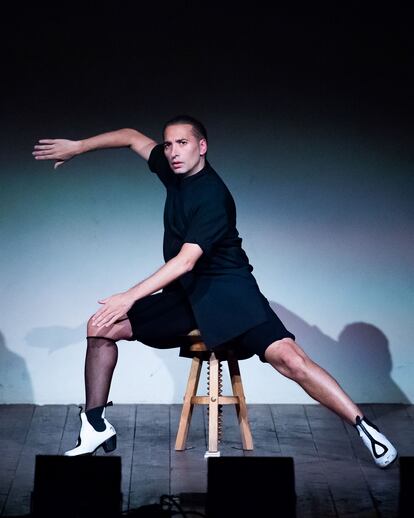There is too much talk around the stage personality, dance and style of Israel Galván (Seville, 1973) who believes she is learned and knowledgeable. Neither one nor the other. It’s not that Galván was born in a distant Cathay: he is from Seville! And his cryptic appearances with his bench-like exits and his almost cartoonish stupor in his way of expressing himself are nothing more than a powerful shield or defensive entelechy: a full theater is an enemy army. He knows this and suffers from it. Today, in 2024, Galván is a mature artist who can allow himself experiments that may not be so much anymore. Is Israel Galván repeated? In certain aspects, yes. This is inevitable if the stage is a laboratory where the dancer-dancer-choreographer is, searching for his own style and voice. Note that the average age of his faithful audience is around fifty; It is also his age. What was groundbreaking when it started, today retains other values, but they are no longer break-and-tear elements. The supposed provocation becomes referential.
Stravinsky’s music has been treated several times in very varied instrumentations, and there is even a version for pianola (which the choreographer Javier de Frutos already used). When the work was brought to London after the high-profile performances in Paris, one critic said that perhaps Stravinsky should have composed a ballet only for percussion. Stravinsky was in bed, and quite seriously, with typhoid fever, so he missed the little London battle and those acidic literary flowers. From this we are left with an interesting couplet: the rhythmic preponderance over any melodic imposition. This seems to interest Galván until he develops intensive usufruct.
Expeditious and cutting, seeking complicity with a pantomime that at times seems disconcerting, Galván makes his overture on the inflatable mat treated with sound, from there he moves on to an exhibition where he judges the scenographic elements, tests them and reproves them. Inadvertently, some pose that recalls the iconography of Nijinsky, which will be secondary, not anecdotal. Also subtly, the dancer goes through the characters of the original work (old man, chosen one, chorus), incorporating them in a breath, instantaneous, like a literary quote.
After listening to the version for two pianos (a scheme to which Stravinsky would return in another very important ballet: The weddings (The wedding, 1923) with 4 pianos, voices and profuse percussion), Galván completes his footage with a very well-known fragment of Scarlatti used inveterately by Spanish dance; This also contains something symbolic, and Israel, as if possessed by a sudden euphoria, plays the conjurer, taking tiny castanets from the harp of one of the pianos (like those used in the times of the Stick Dances) and gives a brushstroke: that’s where we come from.
Throughout the work, the artist alternates the bare foot with the classic boot and strives to distinguish sounds: it continues to be a search for expressive vehicles, whatever they may be: desacralization is in the genetics of this inventor of danced circumstances. If the dancer is alone on stage, his legitimate restlessness takes him to a no man’s land, ambiguous even in appearance, always in a medium-high register that is already difficult to sustain for more than an hour of theatrical action. There is strength and honesty, and it would be worth relating this almost neo-expressionist projection with some versions already enshrined in history, such as the application made by Jane Erdman, a fascinating figure, a prominent founding member of Martha Graham (for whom Massine put together a different version and belongs to The consecration in April 1930 at the Philadelphia Academy of Music) or the later one by Mary Wigman.
Pound said that Stravinsky was the only living artist from whom he could learn his craft. This has not diminished at all today, since all those mentioned are already dead. Galván uses Stravinsky as a conductive and energizing lymph; Auden, who thought the same as Pound, even said that that score was hearts that beat in search of each other. Galván tightens the same rope and gives it to us devoutly and ritually.
Datasheet
Spring consecration: Choreography and dance: Israel Galván; music: Igor Stravinski, D. Scarlatti and F. Rsewski; pianists: Daria van del Bercken and Gerard Bouwhuis; lights: Benito Jiménez and Valentín Donaire; costumes: Micol Notarianni. Conde Duque, Madrid. Until June 8.
Subscribe to continue reading
Read without limits
_

